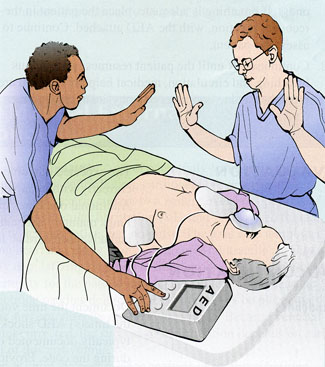Purpose
- To perform automated external defibrillation according to the standard of care.
Assessment
- Assess the client for responsiveness, effective breathing, and circulation.
- Assess for partial or complete airway obstruction. Assess for absent or ineffective respirations.
- AEDs should only be used when a client is not breathing, unresponsive, and without signs of circulation.
Equipment
- AED
- Two prepackaged electrodes
Procedure
-
After discovering that your client is unresponsive to your questions, pulseless, and apneic, follow BLS and ACLS protocols. Call for help and call the code team. Ask a colleague to bring the AED into the client's room and set it up before the code team arrives.
Rationale: Assessing client prevents initiating CPR on a conscious person. Calling for immediate help and code team initiates a rapid response. Performing CPR preserves heart and brain function while awaiting defibrillation.
-
Open the foil packets containing the two electrode pads. Attach the white electrode cable connector to one pad and the red electrode cable connector to the other. The electrode pads are not site specific.
Rationale: Proper setup ensures proper functioning.
-
Expose the client's chest. Remove the plastic backing film from the electrode pads and place the electrode pad attached to the white cable connector on the right upper portion of the client's chest, just beneath the clavicle (Fig. 1).
Rationale: Self-adhesive pads allow hands-free defibrillation.

Fig. 1: AED electrode pad placement.
-
Place the pad attached to the red cable connector to the left of the heart's apex. To help remember where to place the pads, think, "White—right, red—ribs." (Placement for both electrode pads is the same as for manual defibrillation or cardioversion.)
Rationale: Proper setup ensures proper functioning.
- Firmly press the AED's ON button and wait while the machine performs a brief self-test. Most AEDs signal readiness by a computerized voice that says "Stand clear" or by emitting a series of loud beeps. (If the AED were malfunctioning, it would convey the message "Do not use the AED. Remove and continue CPR.") Remember to report any AED malfunctions in accordance with your facility's procedure.
-
Now the machine is ready to analyze the client's heart rhythm. Ask everyone to stand clear and press the ANALYZE button when the machine prompts you to. Be careful not to touch or move the client while the AED is in analysis mode. If you get the message "Check electrodes," make sure the electrodes are correctly placed and the client cable is securely attached; press the ANALYZE button again.
Rationale: Movement and electrical impulses can cause artifact during analysis. Avoiding artifact ensures accurate rhythm analysis. Avoid touching client during this time to avoid accidental shock.
-
In 15 to 30 seconds, the AED will analyze the client's rhythm. When the client needs a shock, the AED will display a "Stand clear" message and emit a beep that changes into a steady tone as it is charging.
Rationale: Standing clear prevents accidental shocking of personnel.
- When an AED is fully charged and ready to deliver a shock, it will prompt you to press the SHOCK button. Some fully automatic AED models automatically deliver a shock within 15 seconds after analyzing the client's rhythm. If a shock is not needed, the AED will display "No shock indicated" and prompt you to "Check client."
-
Make sure no one is touching the client or the bed and call out "Stand clear." Press the shock button on the AED. Most AEDs are ready to deliver a shock within 15 seconds (Fig. 2).
Rationale: Standing clear maintains safety of personnel.

Fig. 2: Clear the client.
-
After the first shock, continue CPR, beginning with 5 cycles of chest compressions for about 2 minutes. Do not delay compressions to recheck rhythm or pulse. After 5 cycles of CPR, the AED should analyze the rhythm and deliver another shock, if indicated.
Rationale: AED reanalysis provides optimal care and reassesses need for continued therapy.
-
If a nonshockable rhythm is detected, the AED should instruct you to resume CPR. Continue this sequence until the code team leader arrives.
Rationale: CPR must be continued until the client resumes spontaneous breathing and circulation, medical help arrives, you are too exhausted to continue CPR, or a physician discontinues CPR.
-
After the code, remove and transcribe the AED's computer memory module or tape or prompt the AED to print a rhythm strip with code data. Follow your facility’s policy for analyzing and storing code data.
Rationale: Documentation helps maintain accurate client records, including effectiveness of medications and treatments.
-
After using an AED, give a synopsis to the code team leader. Remember to report the following:
- The client's name, age, medical history, and chief complaint
- The time you found the client in cardiac arrest
- When you started CPR
- When you applied the AED
- How many shocks the client received
- When the client regained a pulse at any point
- What postarrest care was given, if any
- Physical assessment findings
-
Later, be sure to document the code on the appropriate form.
Rationale: Clear and accurate communication facilitates optimal treatment for client.
| Sample Documentation | ||
| 03/15/10 | 2200 |
Entered room and found client unresponsive and without respirations or pulse. Code team activated, CPR initiated. AED applied at 2202. See code sheet.
S. Roberts RN |
Special Considerations
- AEDs vary from one manufacturer to the next, so familiarize yourself with your facility's equipment.
- AED operation should be checked according to your facility's policy, usually after each use and every 8 hours.
Complications
- Defibrillation can cause accidental electric shock to those providing care. Use of an insufficient amount of conduction medium can lead to skin burns.